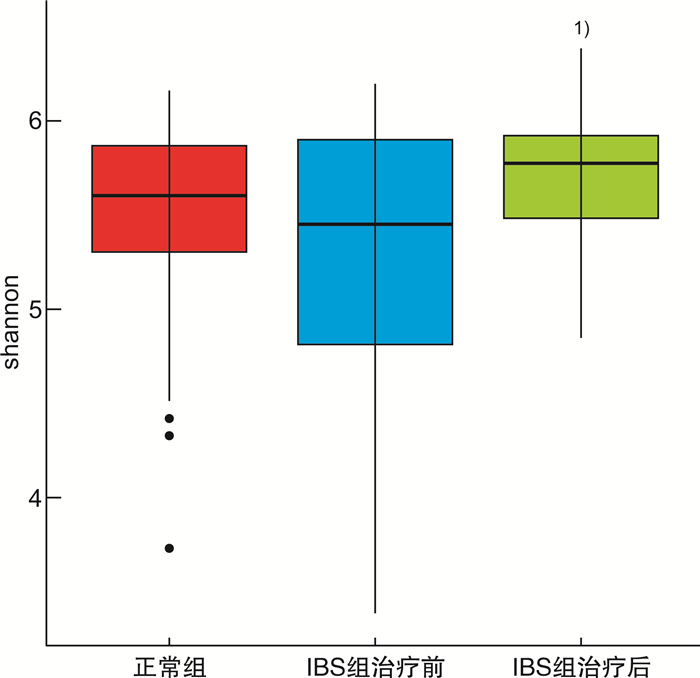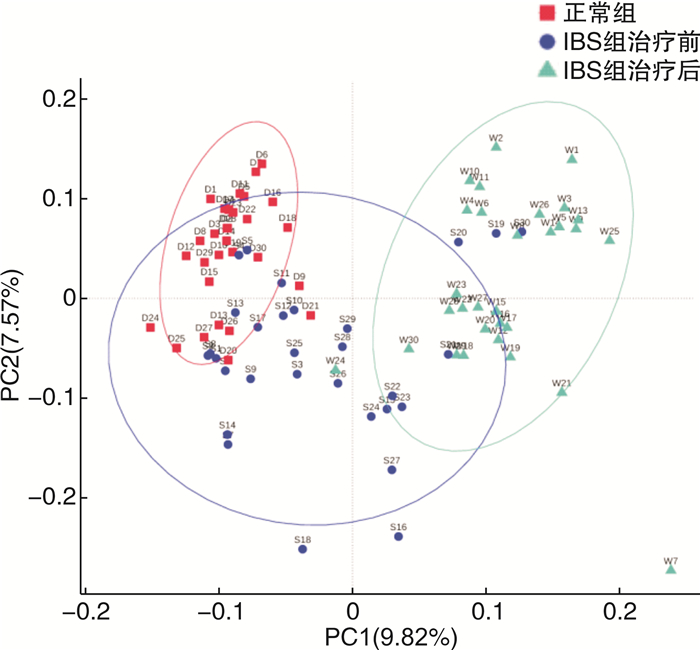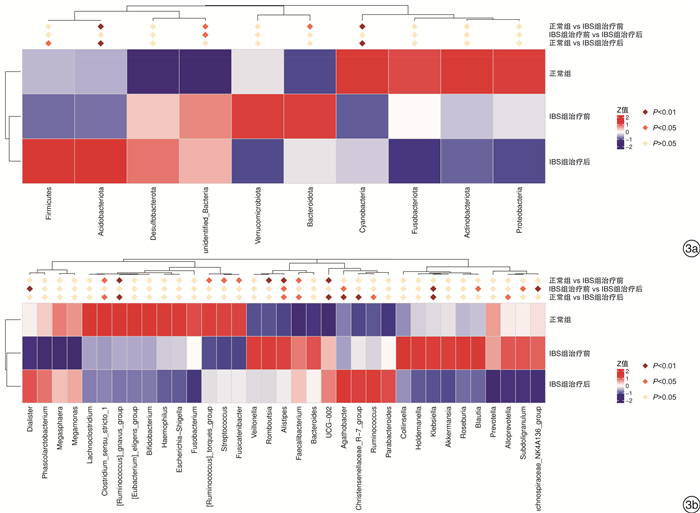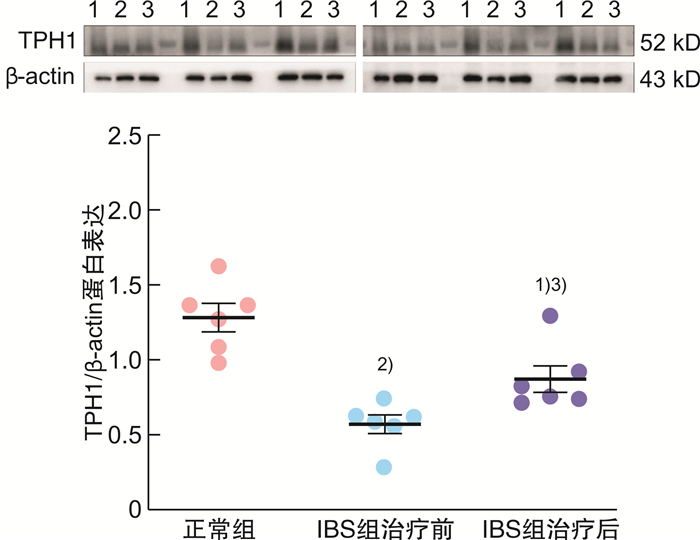Study on the efficacy and mechanism of Umbilicus acupuncture on diarrhea-type irritable bowel syndrome based on gut microbiota and tryptophan metabolism
-
摘要: 目的 探讨脐针通过调节肠道菌群及色氨酸代谢在腹泻型肠易激综合征(diarrhea-type irritable bowel syndrome,IBS-D)治疗上的作用机制。方法 选择30例符合罗马Ⅳ标准的IBS-D患者入组,予脐针治疗,疗程4周。征集30例健康志愿者作基线检测对照。观察健康志愿者及IBS组患者治疗前后的临床症状评分,检测粪便肠道菌群,检测血清色氨酸(TRP)、5-羟色胺(5-HT)、犬尿氨酸(KYN)及吲哚2,3-双加氧酶1(IDO1)浓度,以及结肠色氨酸羟化酶1(TPH1)蛋白表达。结果 经脐针治疗后,IBS患者临床症状评分较治疗前降低(P< 0.01);肠道菌群多样性增加,结构差异明显;IBS患者血清TRP、5-HT、KYN、IDO1浓度较前下降(P< 0.01);结肠TPH1蛋白表达上升(P< 0.05)。结论 脐针治疗能改善IBS-D患者临床症状,其作用机制可能与通过调节肠道菌群及色氨酸代谢,抑制5-HT及KYN生成相关。Abstract: Objective To investigate the mechanism of Umbilicus acupuncture on diarrhea-type irritable bowel syndrome(IBS-D) based on gut microbiota and tryptophan metabolism.Methods Thirty patients with IBS-D who met the Rome Ⅳ diagnostic criteria for IBS-D were enrolled and treated with Umbilicus acupuncture for 4 weeks. Thirty healthy volunteers served as baseline controls. The changes of clinical symptom scores before and after treatment were observed. Gut microbiota were also detected. And serum tryptophan(TRP), 5-hydroxytryptamine(5-HT), kynurenine(KYN), as well as indoleamine 2, 3-dioxygenase1(IDO1) were recorded. The colonic tryptophan hydroxylase1(TPH1) protein expression was detected before and after treatment.Results The clinical symptom scores of IBS patients after treatment in IBS group were lower than those before treatment(P< 0.01). The diversity of gut microbiota was increased, and significant differences were in gut microbiota structure. The levels of TRP, 5-HT, KYN and IDO1 were also decreased(P< 0.01). Colonic TPH1 expression levels were increased after treatment(P< 0.05).Conclusion Umbilicus acupuncture can improve the clinical symptoms of IBS-D patients, and its mechanism of action may be related to the inhibition of 5-HT and KYN production by regulating gut microbiota and tryptophan metabolism.
-

-
表 1 2组患者治疗前后IBS-SSS评分
分,X±S 组别 例数 观测时点 IBS-SSS 正常组 30 20.17±4.11 IBS组 30 治疗前 281.80±14.371) 治疗后 102.70±10.112) 与正常组比较,1)P < 0.01;与IBS组治疗前比较,2)P < 0.01。 表 2 2组患者治疗前后Bristol评分及排便频率评分
分,M(P25,P75) 组别 例数 观测时点 Bristol评分 排便频率 正常组 30 4(4,5) 3(3,3) IBS组 30 治疗前 6(6,7)1) 5(4.75,6)1) 治疗后 4(4,5)2) 3(3,4)2) 与正常组比较,1)P < 0.01;与IBS组治疗前比较,2)P < 0.01。 表 3 正常组和IBS组治疗前门及属水平差异菌群
菌群结构 正常组(丰度) IBS组治疗前(丰度) P 增减 门 Bacteroidota 0.313201197 0.250301947 0.037 减少 Cyanobacteria 0.000003460 0.001300590 <0.001 增加 Acidobacteriota 0.000001390 0.000043600 0.003 增加 属 Faecalibacterium 0.160179645 0.116923599 0.040 减少 Clostridium 0.002557550 0.006413613 0.046 增加 Fusicatenibacter 0.009211474 0.014392365 0.020 增加 Streptococcus 0.004804842 0.009632538 0.038 增加 Romboutsia 0.014589739 0.008054240 0.009 减少 Alistipes 0.018322530 0.007267514 0.001 减少 表 4 IBS组治疗前后门及属水平差异菌群
菌群结构 IBS组治疗前(丰度) IBS组治疗后(丰度) P 增减 门 unidentified_Bacteria 0.001425247 0.002543699 0.040 增加 属 Faecalibacterium 0.116923599 0.151519433 0.017 增加 Klebsiella 0.005671210 0.001345605 0.006 减少 Agathobacter 0.022396050 0.033899831 0.005 增加 Clostridium 0.006413613 0.002336630 0.016 减少 Alloprevotella 0.002608798 0.000909305 0.038 减少 Alistipes 0.007267514 0.011891604 0.021 增加 Christensenellaceae 0.001611540 0.004626167 0.004 增加 表 5 正常组及IBS组患者治疗前后TRP、5-HT、KYN、IDO1浓度
X±S 组别 例数 观测时点 TRP/(μmol·L-1) 5-HT/(ng·mL-1) KYN/(nmol·L-1) IDO1/(IU·mL-1) 正常组 30 51.45±1.77 164.61±7.98 1530.80±38.29 18.17±0.82 IBS组 30 治疗前 61.90±2.031) 265.48±9.691) 1795.14±36.791) 35.46±1.711) 治疗后 54.23±1.642) 219.17±8.772) 1587.12±33.732) 29.77±1.412) 与正常组比较,1)P < 0.01;与IBS组治疗前比较,2)P < 0.01。 -
[1] Ghoshal UC. Pros and Cons While Looking Through an Asian Window on the Rome Ⅳ Criteria for Irritable Bowel Syndrome: Pros[J]. J Neurogastroenterol Motil, 2017, 23(3): 334-340. doi: 10.5056/jnm17020
[2] Oka P, Parr H, Barberio B, et al. Global prevalence of irritable bowel syndrome according to Rome Ⅲ or Ⅳ criteria: a systematic review and meta-analysis[J]. Lancet Gastroenterol Hepatol, 2020, 5(10): 908-917. doi: 10.1016/S2468-1253(20)30217-X
[3] Kamiya T, Osaga S, Kubota E, et al. Questionnaire-Based Survey on Epidemiology of Functional Gastrointestinal Disorders and Current Status of Gastrointestinal Motility Testing in Asian Countries[J]. Digestion, 2020, 102(1): 73-89.
[4] 俞蕾敏, 张娅丽, 王延武, 等. 脐针治疗腹泻型肠易激综合征疗效及对脑肠肽的影响[J]. 世界华人消化杂志, 2020, 28(13): 538-543. https://www.cnki.com.cn/Article/CJFDTOTAL-XXHB202013009.htm
[5] Agus A, Planchais J, Sokol H. Gut Microbiota Regulation of Tryptophan Metabolism in Health and Disease[J]. Cell Host Microbe, 2018, 23(6): 716-724. doi: 10.1016/j.chom.2018.05.003
[6] Liu HN, Wu H, Chen YZ, et al. Altered molecular signature of intestinal microbiota in irritable bowel syndrome patients compared with healthy controls: A systematic review and meta-analysis[J]. Dig Liver Dis, 2017, 49(4): 331-337. doi: 10.1016/j.dld.2017.01.142
[7] 杜佳欣. 肠道菌群组成影响低FODMAPs饮食治疗IBS患者的临床疗效[D]. 济南: 山东大学医学院, 2016.
[8] Zhao JM, Lu JH, Yin XJ, et al. Comparison of electroacupuncture and moxibustion on brain-gut function in patients with diarrhea-predominant irritable bowel syndrome: A randomized controlled trial[J]. Chin J Integr Med, 2015, 21(11): 855-865. doi: 10.1007/s11655-015-2049-x
[9] Ancona A, Petito C, Iavarone I, et al. The gut-brain axis in irritable bowel syndrome and inflammatory bowel disease[J]. Dig Liver Dis, 2021, 53(3): 298-305. doi: 10.1016/j.dld.2020.11.026
[10] Herndon CC, Wang YP, Lu CL. Targeting the gut microbiota for the treatment of irritable bowel syndrome[J]. Kaohsiung J Med Sci, 2020, 36(3): 160-170. doi: 10.1002/kjm2.12154
[11] De Palma G, Lynch MD, Lu J, et al. Transplantation of fecal microbiota from patients with irritable bowel syndrome alters gut function and behavior in recipient mice[J]. Sci Transl Med, 2017, 9(379): eaaf6397. doi: 10.1126/scitranslmed.aaf6397
[12] Tap J, Derrien M, Törnblom H, et al. Identification of an Intestinal Microbiota Signature Associated With Severity of Irritable Bowel Syndrome[J]. Gastroenterology, 2017, 152(1): 111-123. e8. doi: 10.1053/j.gastro.2016.09.049
[13] Ma N, Ma X. Dietary Amino Acids and the Gut-Microbiome-Immune Axis: Physiological Metabolism and Therapeutic Prospects[J]. Compr Rev Food Sci Food Saf, 2019, 18(1): 221-242. doi: 10.1111/1541-4337.12401
[14] Agus A, Planchais J, Sokol H. Gut Microbiota Regulation of Tryptophan Metabolism in Health and Disease[J]. Cell Host Microbe, 2018, 23(6): 716-724. doi: 10.1016/j.chom.2018.05.003
[15] 周脉涛. 颈交感干离断对慢性抑郁大鼠行为学的影响及色氨酸代谢相关机制[D]. 苏州: 苏州大学, 2014.
[16] Kerckhoffs AP, ter Linde JJ, Akkermans LM, et al. SERT and TPH-1 mRNA expression are reduced in i-rritable bowel syndrome patients regardless of visceral se-nsitivity state in large intestine[J]. Am J Physiol Gastrointe-st Liver Physiol, 2012, 302(9): G1053-G1060. doi: 10.1152/ajpgi.00153.2011
[17] 包春辉, 钟捷, 刘慧荣, 等. 针灸对活动期克罗恩病患者负性情绪及血浆色氨酸代谢的影响[J]. 中国针灸, 2021, 41(1): 17-22. https://www.cnki.com.cn/Article/CJFDTOTAL-ZGZE202101008.htm
[18] 杨苑, 张宁, 段渠. 脐针疗法的临床应用与研究进展[J]. 云南中医中药杂志, 2018, 39(1): 88-90. https://www.cnki.com.cn/Article/CJFDTOTAL-YZYY201801042.htm
[19] 裴丽霞, 孙建华, 夏晨, 等. 针灸治疗腹泻型肠易激综合征肝郁脾虚证临床研究[J]. 南京中医药大学学报, 2012, 28(1): 27-29. doi: 10.3969/j.issn.1000-5005.2012.01.009
[20] 王春烨, 包春辉, 丁邦友, 等. 肠道菌群及其代谢产物在针灸调节肠易激综合征中作用概述[J]. 世界科学技术-中医药现代化, 2018, 20(5): 756-761. https://www.cnki.com.cn/Article/CJFDTOTAL-SJKX201805024.htm
[21] 李旗, 田福玲, 郭振宇, 等. 浮针疗法对轻中度腹泻型肠易激综合征患者内脏敏感性、胃肠动力、肠道菌群及肠黏膜屏障功能的影响研究[J]. 中国全科医学, 2021, 24(9): 1111-1115, 1130. https://www.cnki.com.cn/Article/CJFDTOTAL-QKYX202109039.htm
[22] O'Mahony SM, Clarke G, Borre YE, et al. Serotonin, tryptophan metabolism and the brain-gut-microbiome axis[J]. Behav Brain Res, 2015, 277: 32-48. doi: 10.1016/j.bbr.2014.07.027
-





 下载:
下载:


